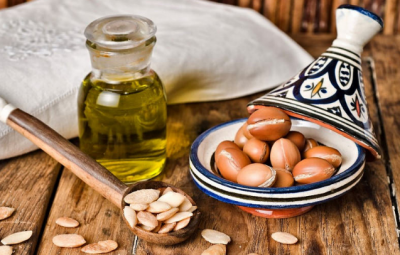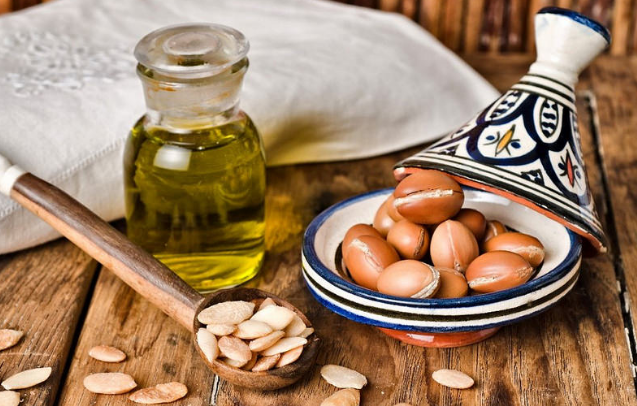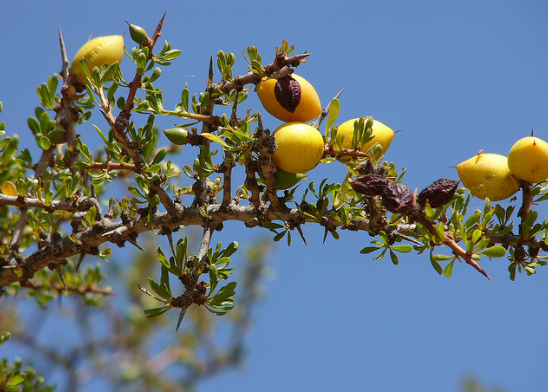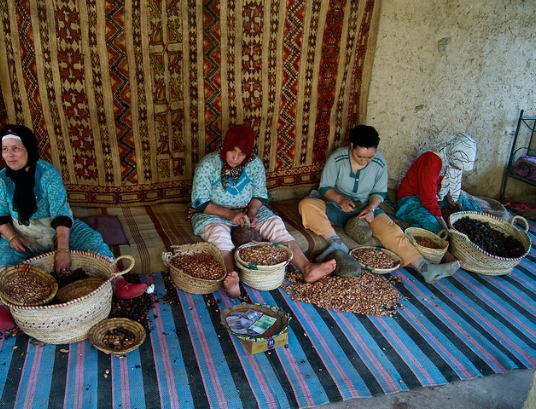The argan tree grows in Morocco; its fruits are a source of nutrient-enriched oil. Once upon a time, these trees grew throughout North Africa, and their fruits were extracted from the dung of goats who climbed the trees trying to find food. It is not surprising that this method of harvesting has remained in the past, now the fruits of argania grow only in some semi-desert regions, and they are collected by hand.
The fruit contains about 30% to 50% of the oil, but you have to go through several stages in order to get it. First, the fruits are dried outdoors, and then the flesh is removed. Some modern manufacturers do this work mechanically, without pre-drying, and the pulp is usually used as animal feed. The next step is the extraction of kernel from the nut. The attempts to mechanize this part of the process were unsuccessful, so employees do it manually. Despite the fact that this work requires special efforts, it is performed mostly by women. The nuts that will be used for the production of edible oil are fried, then cooled, split and only then the precious oil is squeezed out.
The fruit contains about 30% to 50% of the oil, but you have to go through several stages in order to get it. First, the fruits are dried outdoors, and then the flesh is removed. Some modern manufacturers do this work mechanically, without pre-drying, and the pulp is usually used as animal feed. The next step is the extraction of kernel from the nut. The attempts to mechanize this part of the process were unsuccessful, so employees do it manually. Despite the fact that this work requires special efforts, it is performed mostly by women. The nuts that will be used for the production of edible oil are fried, then cooled, split and only then the precious oil is squeezed out.
The process of cosmetic oil production is practically the same, except that no preliminary roasting of the nuts is required, and the decanted oil is left for two weeks to allow the solid particles to settle to the bottom.
This really valuable product contains oleic, linoleic, palmitic and stearic fatty acids, as well as tocopherol (vitamin E), phenols, carotenes, squalene, caffeic acid, oleuropein, tyrazole and catechol.
The edible oil has a dark brown color and an earthy or slightly smoky aroma. It does not have a bright taste and aroma, like pumpkin oil. It looks like a peanut butter.
Since the production process is expensive and time consuming, argan oil is one of the most expensive edible oils. Its healing properties make it even more expensive, as it is used in the fight against cholesterol, for the treatment of the digestive system, eczema and arthritis.
This really valuable product contains oleic, linoleic, palmitic and stearic fatty acids, as well as tocopherol (vitamin E), phenols, carotenes, squalene, caffeic acid, oleuropein, tyrazole and catechol.
The edible oil has a dark brown color and an earthy or slightly smoky aroma. It does not have a bright taste and aroma, like pumpkin oil. It looks like a peanut butter.
Since the production process is expensive and time consuming, argan oil is one of the most expensive edible oils. Its healing properties make it even more expensive, as it is used in the fight against cholesterol, for the treatment of the digestive system, eczema and arthritis.
Due to the fact that argan oil is rather expensive, it is not used for frying and stewing, unlike sunflower oil or olive oil. It is usually poured on shredded greens to combine flavors and aroma, and then added to salads, ready-made meals and marinades.
Recently, the leading chefs of the world drew their attention to this "liquid gold". They use it to emphasize the taste of stew or steak, couscous and even ice cream, and a mixture of argan oil with grapefruit juice is used to flavor fish and other seafood.
The world is constantly changing, the usual products are receding into the background, and those that have been forgotten return to the kitchen again. Whatever products you prefer to use, the main thing is that they are both tasty and useful.
Recently, the leading chefs of the world drew their attention to this "liquid gold". They use it to emphasize the taste of stew or steak, couscous and even ice cream, and a mixture of argan oil with grapefruit juice is used to flavor fish and other seafood.
The world is constantly changing, the usual products are receding into the background, and those that have been forgotten return to the kitchen again. Whatever products you prefer to use, the main thing is that they are both tasty and useful.








